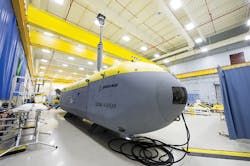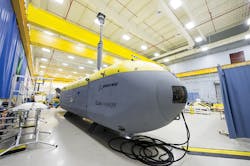Military research projects may be coming together to put large long-endurance UUVs in sight
U.S. military research programs are taking shape to develop enabling technologies for large long-endurance unmanned underwater vehicles (UUVs) able to operate independently for long periods over long distances to deploy surveillance sensors and weapons in global hot spots where necessary.
These projects are led by scientists at the U.S. Defense Advanced Research Projects Agency (DARPA) in Arlington, Va., and the Office of Naval Research (ONR) in Arlington, Va.
One of the latest developments is an industry solicitation by DARPA for the Hunter program to develop an advanced payload delivery system for extra-large UUVs.
Payloads potentially could involve persistent-surveillance sensors, weapons, or other UUVs and unmanned aerial vehicles (UAVs). Details of the Hunter program are classified and available only to companies with the proper security credentials.
Separately, DARPA is pursuing the Hydra program to develop an unmanned submersible large enough to transport and deploy UAVs and UUVs stealthily in enemy territory to respond quickly to situations around the world.
Enabling technologies to be developed in the Hunter program have the potential to add to the Hydra UUV's capabilities, and perhaps could expand the Hydra submersible's mission beyond deploying unmanned reconnaissance submarines and aircraft.
The DARPA Hydra large UUV program has been in progress for nearly three years, and involves the Boeing Co. Defense, Space & Security segment in Huntington Beach, Calif., and Hydroid Inc. in Pocasset, Mass.
Boeing has developed the Echo Voyager, a 51-foot large UUV that can reach depths of 11,000 feet and can operate independently for months underwater. Boeing unveiled the Echo Voyager one year ago and began sea trials of the unmanned undersea craft last summer.
Hydroid, meanwhile, offers a family of UUVs called the Remote Environmental Measuring Units (REMUS). The largest of these is the REMUS 6000. Although not nearly the size of the Boeing Echo Voyager, the REMUS 6000 is 13 feet long and 28 inches in diameter. It can reach depths of nearly 20,000 feet.
Hydroid engineers developed the REMUS 6000 together with the Naval Oceanographic Office, the Office of Naval Research, and the Woods Hole Oceanographic Institution. Hydroid is a subsidiary of Kongsberg Maritime in Kongsberg, Norway.
Separately from the DARPA Hydra program, the Office of Naval Research is working on the Large Displacement Unmanned Undersea Vehicle (LDUUV) for a wide variety of applications like long-range surveillance.
The LDUUV is to operate in the open ocean and in coastal waters and harbors on missions lasting more than 70 days. The large unmanned submersible is to be a pier-launched and recovered. The project's primary goals are to develop enabling technologies in machine autonomy and long-endurance propulsion.
Companies involved in the LDUUV program include: Metron Inc. in Reston, Va., which is working machine intelligence; Hydroid, which is developing an autonomy testing system; Fuelcell Energy Inc. in Danbury, Conn.; Sierra Lobo Inc. in Fremont, Ohio; the Hamilton Sundstrand Corp. Sea Systems segment in Windsor Locks, Conn.; General Atomics in San Diego; Lynntech Inc. in College Station, Texas; and NexTech Materials Ltd. in Lewis Center, Ohio.
With machine intelligence, long-endurance propulsion, and other crucial UUV technologies under development in the Hydra and LDUUV programs, the DARPA Hunter payload delivery system could be just the technology to provide real intelligence and reconnaissance capabilities for future large unmanned submarines.

